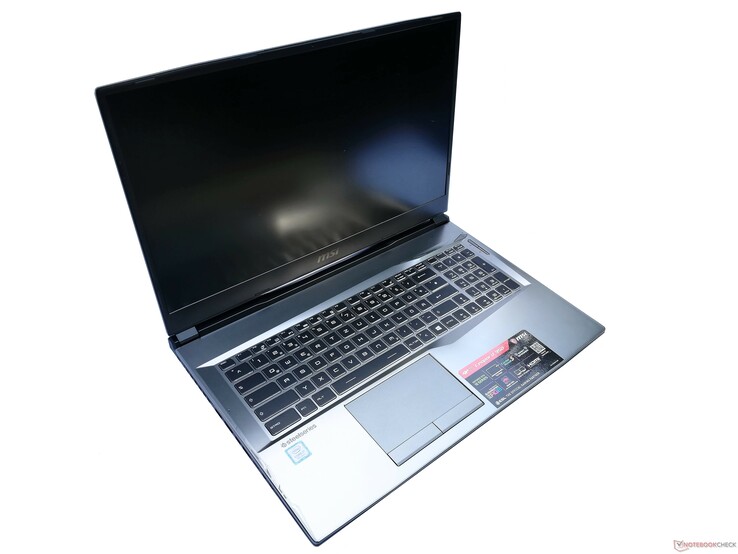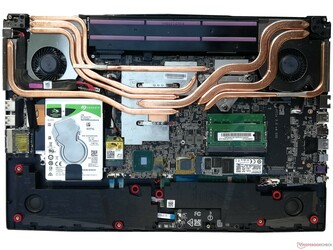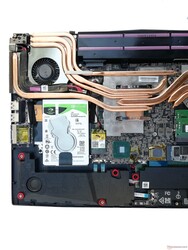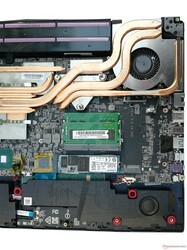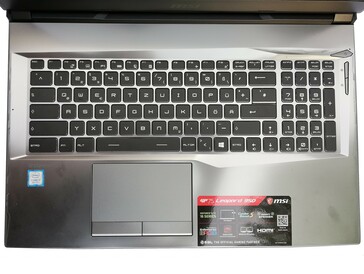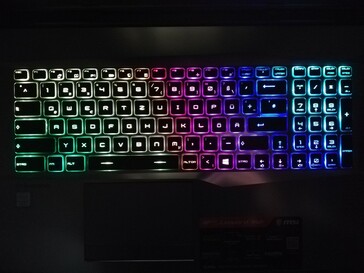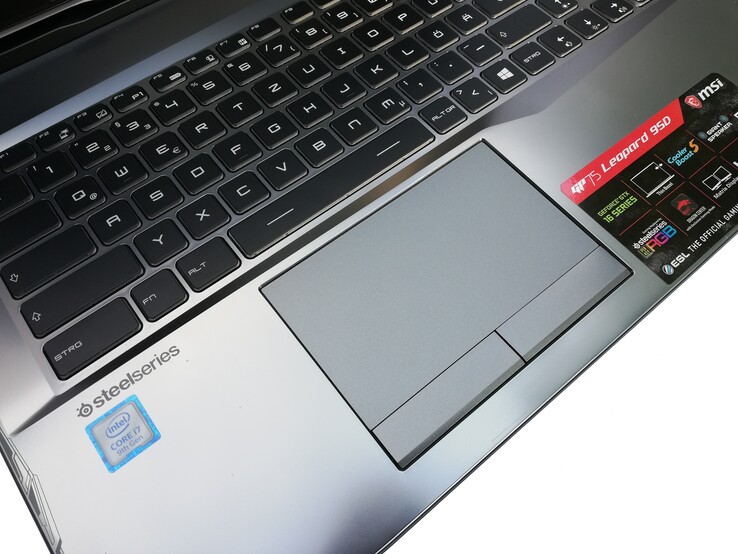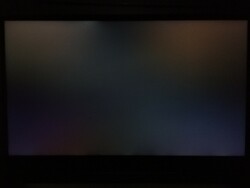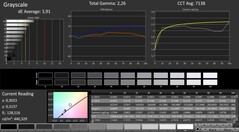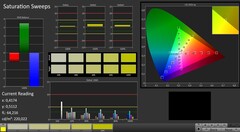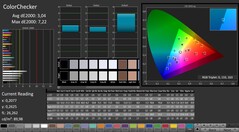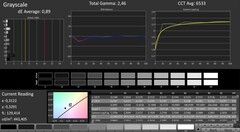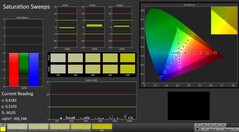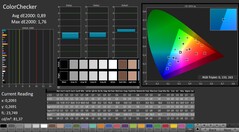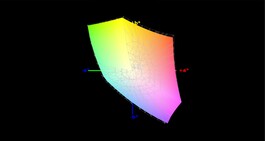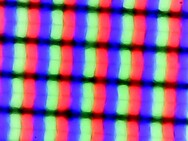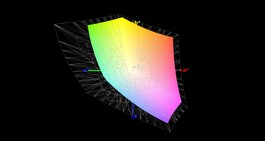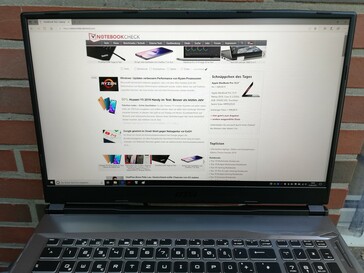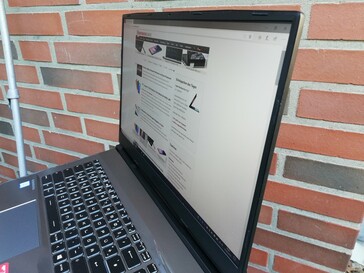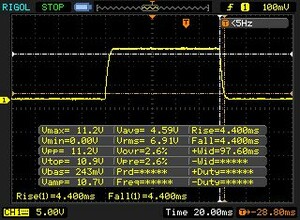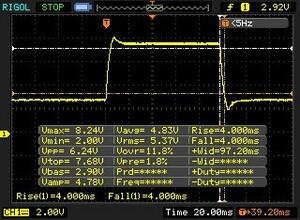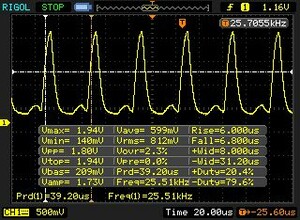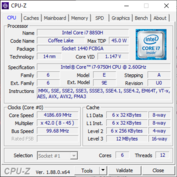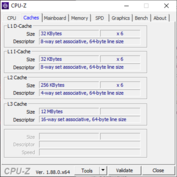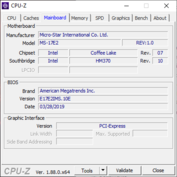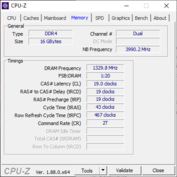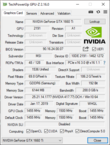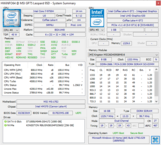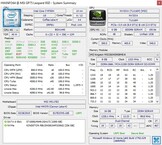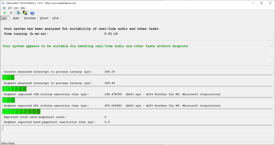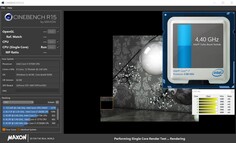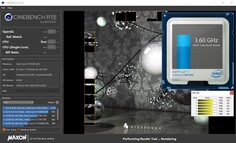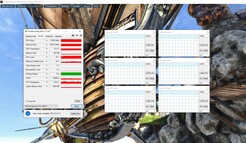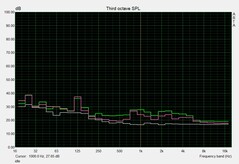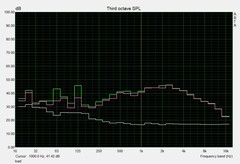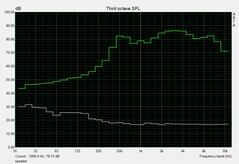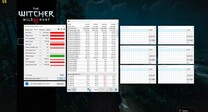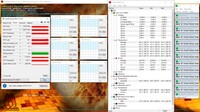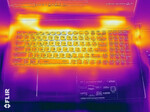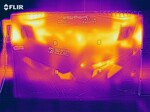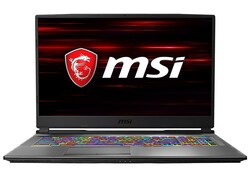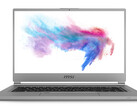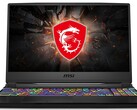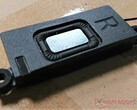Review of the MSI GP75 Leopard 9SD: Low-priced Gaming Laptop with a 144 Hz Panel
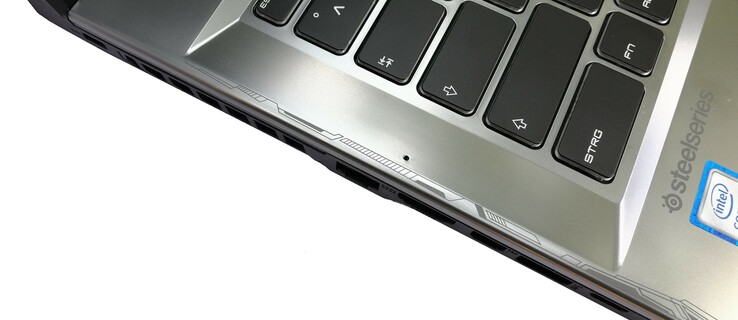
MSI is known for its large selection of gaming notebooks. It offers a lot of high-priced options for premium customers. However, MSI also offers devices that price-conscious customers might find very attractive. The notebooks from the GP series are suited for those who can live without the highest performance and the best design. When we reviewed the MSI GP63 Leopard 8RE and the MSI GP72VR, we found that these two devices were suited exactly for that kind of clientele and that they offered very good price-to-performance ratios.
For 1800 Euros ($2032), the MSI GP75 Leopard 9SD offers an Intel Core i7-9750H and 16 GB of RAM. Nvidia’s GeForce GTX 1660 Ti is used for image rendering and a combination of a 256 GB SSD and a 1 TB HDD provides enough storage space for applications, games and user data. All of this is good enough to satisfy the basic requirements of a capable gaming notebook.
The competing manufacturers also offer capable gaming devices at a similar price. The competing devices include: The Lenovo Legion Y530, the CUK Model Z, the Dell G5 15 5590 and the Aorus 15-W9.
Case - Rigid gaming notebook made of plastic
The chassis is made of rigid plastic, which only bends slightly in the wrist rest area when a lot of pressure is applied. The build quality is very solid and we did not observe any defects such as chinks where pieces of plastic meet. The GP75 Leopard looks quite good for a gaming laptop. Clean lines and individual accents dominate the design. Moreover, the sides of the device are adorned with imprinted patterns. The bezels are also small, which is in keeping with the current trend.
At a weight of 2.6 kg (~5.7 lb), the GP75 Leopard 9SD is one of the heavier notebooks in our comparison chart. The dimensions are also somewhat larger. The width of the device is determined by its 17-inch display. The MSI laptop is somewhat thicker than other comparable notebooks. However, its depth is very reasonable.
Connectivity - GP75 Leopard 9SD with a USB 3.2 Type-C port
The MSI GP75 Leopard offers a good selection of ports. All ports, whether they are Type-C or Type-A, operate at USB 3.2 speeds. The maximum transfer speed for Gen1 ports is 5 GB/s and for Gen2 ports 10 GB/s. Moreover, the HDMI port can output content in 4K at 60 FPS.
SD Card Reader
The built-in SD card reader does not “swallow” SD cards whole, which is why they protrude 5 mm (~0.2 in) from the chassis. In our benchmark with the reference-grade SD card (Toshiba Exceria Pro SDXC 64 GB UHS-II), the MSI notebook achieves subpar write and read speeds. However, the SD card readers of other gaming notebooks also achieve mediocre transfer rates, provided that they are included at all.
| SD Card Reader | |
| average JPG Copy Test (av. of 3 runs) | |
| Average of class Gaming (20 - 210, n=68, last 2 years) | |
| CUK Model Z GK5CQ7Z (Toshiba Exceria Pro SDXC 64 GB UHS-II) | |
| MSI GP75 Leopard 9SD (Toshiba Exceria Pro SDXC 64 GB UHS-II) | |
| Dell G5 15 5590 (Toshiba Exceria Pro SDXC 64 GB UHS-II) | |
| maximum AS SSD Seq Read Test (1GB) | |
| Average of class Gaming (25.8 - 261, n=65, last 2 years) | |
| CUK Model Z GK5CQ7Z (Toshiba Exceria Pro SDXC 64 GB UHS-II) | |
| Dell G5 15 5590 (Toshiba Exceria Pro SDXC 64 GB UHS-II) | |
| MSI GP75 Leopard 9SD (Toshiba Exceria Pro SDXC 64 GB UHS-II) | |
Communication
In addition to a Gigabit Ethernet port, the GP75 Leopard 9SD also features a Wi-Fi adapter that supports the fast 802.11ac standard and can operate in 5 GHz networks. Thanks to a 2x2 MIMO antenna, the MSI notebook achieves a download speed of 690 Mb/s and an upload speed of 676 Mb/s.
| Networking | |
| iperf3 transmit AX12 | |
| Aorus 15 W9 | |
| MSI GP75 Leopard 9SD | |
| Dell G5 15 5590 | |
| CUK Model Z GK5CQ7Z | |
| Lenovo Legion Y530-15ICH | |
| iperf3 receive AX12 | |
| MSI GP75 Leopard 9SD | |
| Aorus 15 W9 | |
| Dell G5 15 5590 | |
| CUK Model Z GK5CQ7Z | |
| Lenovo Legion Y530-15ICH | |
Accessories
The box contains the laptop itself and the power adapter. MSI does not offer any additional accessories that were specifically designed for the GP75. However, you can get various MSI-branded accessories such as headphones, keyboards and mice from MSI’s online store.
Maintenance
Warranty
The MSI GP75 Leopard 9SD comes with a 24-month warranty. To learn more, visit our FAQ, which has a section that deals with warranty, return policy and other related issues.
Input Device - Cheap MSI laptop with an RGB keyboard backlight
Keyboard
The keyboard of the GP75 Leopard 9SD is well-suited for typing. It does not provide a lot of feedback and has a somewhat clear actuation point. The keys do not produce any noise, which is why the MSI notebook can be used in quiet environments. The colors of the keys can be mapped individually in the preinstalled utility and the RGB backlight covers all the colors of the rainbow. Users can choose between static and active lighting patterns.
TouchPad
The GP75 Leopard 9SD uses a TouchPad with individual hardware buttons as a replacement for the mouse. The surface of the TouchPad is very smooth, which is why users can move the cursor with a lot of precision. The mouse buttons offer a clear actuation point and are easy to press, even though they do put up a little resistance. Unlike the keyboard, the TouchPad does not feature any illuminable elements.
Display - Gaming notebook with a 144 Hz Full HD screen
The GP75 Leopard 9SD comes with an IPS panel with a native resolution of 1920x1080. The refresh rate amounts to 144 Hz and the response time to 3 ms. Thanks to an average brightness of 393 cd/m² and a brightness distribution of 91%, the MSI notebook takes a spot at the top of our comparison chart. At 17% brightness, the display starts to flicker with a frequency of 25510 Hz. Because the PWM frequency is so high, susceptible individuals should not experience any discomfort after looking at the screen for long periods of time.
As an alternative, buyers of the GP75 Leopard 9SD can get a screen without the 144 Hz refresh rate.
| |||||||||||||||||||||||||
Brightness Distribution: 91 %
Center on Battery: 420 cd/m²
Contrast: 1313:1 (Black: 0.32 cd/m²)
ΔE ColorChecker Calman: 3.04 | ∀{0.5-29.43 Ø4.79}
calibrated: 0.89
ΔE Greyscale Calman: 3.91 | ∀{0.09-98 Ø5}
95% sRGB (Argyll 1.6.3 3D)
60% AdobeRGB 1998 (Argyll 1.6.3 3D)
65.1% AdobeRGB 1998 (Argyll 3D)
94.9% sRGB (Argyll 3D)
63.4% Display P3 (Argyll 3D)
Gamma: 2.26
CCT: 7138 K
| MSI GP75 Leopard 9SD Chi Mei N173HCE-G33 (CMN175C), IPS, 1920x1080, 17.3" | Lenovo Legion Y530-15ICH LG Display LP156WFG-SPB2, IPS, 1920x1080, 15.6" | CUK Model Z GK5CQ7Z LG Philips LGD05C0, IPS, 1920x1080, 15.6" | Dell G5 15 5590 AU Optronics B156HAN, IPS, 1920x1080, 15.6" | Aorus 15 W9 LG Philips LP156WFG-SPB2 (LGD05E8), IPS, 1920x1080, 15.6" | MSI GS75 8SG Stealth N173HCE-G33 (CMN175C), IPS, 1920x1080, 17.3" | |
|---|---|---|---|---|---|---|
| Display | -2% | 0% | -38% | 0% | 1% | |
| Display P3 Coverage (%) | 63.4 | 62.5 -1% | 64.5 2% | 39.26 -38% | 64.3 1% | 63.6 0% |
| sRGB Coverage (%) | 94.9 | 93 -2% | 93 -2% | 59.1 -38% | 93.5 -1% | 95.4 1% |
| AdobeRGB 1998 Coverage (%) | 65.1 | 63.8 -2% | 65.7 1% | 40.56 -38% | 65.6 1% | 65.5 1% |
| Response Times | -57% | -53% | -352% | -78% | -2% | |
| Response Time Grey 50% / Grey 80% * (ms) | 8 ? | 15 ? -88% | 13.6 ? -70% | 45 ? -463% | 16.8 ? -110% | 7.6 ? 5% |
| Response Time Black / White * (ms) | 8.8 ? | 11 ? -25% | 12 ? -36% | 30 ? -241% | 12.8 ? -45% | 9.6 ? -9% |
| PWM Frequency (Hz) | 25510 ? | 25510 ? | ||||
| Screen | -26% | -21% | -84% | -21% | 14% | |
| Brightness middle (cd/m²) | 420 | 305 -27% | 306.8 -27% | 234 -44% | 295 -30% | 355 -15% |
| Brightness (cd/m²) | 393 | 284 -28% | 309 -21% | 219 -44% | 292 -26% | 327 -17% |
| Brightness Distribution (%) | 91 | 83 -9% | 87 -4% | 82 -10% | 80 -12% | 85 -7% |
| Black Level * (cd/m²) | 0.32 | 0.52 -63% | 0.38 -19% | 0.17 47% | 0.34 -6% | 0.26 19% |
| Contrast (:1) | 1313 | 587 -55% | 807 -39% | 1376 5% | 868 -34% | 1365 4% |
| Colorchecker dE 2000 * | 3.04 | 3.63 -19% | 3.16 -4% | 8.6 -183% | 3.89 -28% | 1.54 49% |
| Colorchecker dE 2000 max. * | 7.22 | 8.18 -13% | 6.05 16% | 17.49 -142% | 7.28 -1% | 3 58% |
| Colorchecker dE 2000 calibrated * | 0.89 | 1.31 -47% | 2.4 -170% | 4.06 -356% | 1.44 -62% | 0.77 13% |
| Greyscale dE 2000 * | 3.91 | 4.77 -22% | 2.3 41% | 8.55 -119% | 4.98 -27% | 2.19 44% |
| Gamma | 2.26 97% | 2.54 87% | 2.17 101% | 3.02 73% | 2.45 90% | 2.42 91% |
| CCT | 7138 91% | 7500 87% | 6557 99% | 7802 83% | 6407 101% | 6893 94% |
| Color Space (Percent of AdobeRGB 1998) (%) | 60 | 59 -2% | 60 0% | 37 -38% | 60 0% | 61 2% |
| Color Space (Percent of sRGB) (%) | 95 | 93 -2% | 92.6 -3% | 59 -38% | 93 -2% | 95 0% |
| Total Average (Program / Settings) | -28% /
-25% | -25% /
-21% | -158% /
-109% | -33% /
-24% | 4% /
9% |
* ... smaller is better
According to our measurements, the screen of the GP75 Leopard 9SD has a very good contrast ratio of 1313:1 and a slightly elevated black value of 0.32 cd/m². This is why the colors are easy to tell apart and the dark hues look rather washed-out. The color space coverage of 95% for sRGB and 60% for Adobe RGB is on a normal level for such a device.
The CalMAN analysis reveals that the screen of the GP75 Leopard 9SD suffers from a bluish cast straight out of the box. This issue can be completely resolved through calibration. You can download our ICC profile at the bottom of the box that contains all display measurements (this box is located to the left of the graphic showing the distribution of brightness).
The MSI GP75 Leopard 9SD can be used outdoors, as long as it is in the shade. Because of a matte screen surface, there are no reflections of the objects in the environment on the screen. Having said that, the display is simply not bright enough to be legible in direct sunlight.
Display Response Times
| ↔ Response Time Black to White | ||
|---|---|---|
| 8.8 ms ... rise ↗ and fall ↘ combined | ↗ 4.4 ms rise | |
| ↘ 4.4 ms fall | ||
| The screen shows fast response rates in our tests and should be suited for gaming. In comparison, all tested devices range from 0.1 (minimum) to 240 (maximum) ms. » 23 % of all devices are better. This means that the measured response time is better than the average of all tested devices (20.3 ms). | ||
| ↔ Response Time 50% Grey to 80% Grey | ||
| 8 ms ... rise ↗ and fall ↘ combined | ↗ 4 ms rise | |
| ↘ 4 ms fall | ||
| The screen shows fast response rates in our tests and should be suited for gaming. In comparison, all tested devices range from 0.165 (minimum) to 636 (maximum) ms. » 19 % of all devices are better. This means that the measured response time is better than the average of all tested devices (31.7 ms). | ||
Screen Flickering / PWM (Pulse-Width Modulation)
| Screen flickering / PWM detected | 25510 Hz | ≤ 17 % brightness setting | |
The display backlight flickers at 25510 Hz (worst case, e.g., utilizing PWM) Flickering detected at a brightness setting of 17 % and below. There should be no flickering or PWM above this brightness setting. The frequency of 25510 Hz is quite high, so most users sensitive to PWM should not notice any flickering. In comparison: 53 % of all tested devices do not use PWM to dim the display. If PWM was detected, an average of 8167 (minimum: 5 - maximum: 343500) Hz was measured. | |||
Performance - GP75 Leopard offers good system performance
The MSI GP75 Leopard 9SD comes with an Nvidia GeForce GTX 1660 Ti. There are several CPU and memory configuration options to choose from. Our review model has an Intel Core i7-9750H, 16 GB of RAM, a 256 GB SSD and a 1 TB HDD. The RAM can be upgraded to 64 GB. There are two M.2 slots and one 2.5-inch drive.
Processor
The Intel Core i7-9750H is a Coffee Lake-based hexa-core CPU. Its clock speed ranges from 2.6 to 4.5 GHz and it can process up to 12 threads at the same time. The amount of time a processor can run at its boost clock is influenced very significantly by the capabilities of the cooling solution.
In our CineBench R15 stress test, the performance drops by 6% shortly after the start of the test. After that the clock rates stabilize. When compared to other notebooks with similar hardware, the performance of the GP75 Leopard 9SD disappoints. The i7-9750H does very well in the single-core benchmarks, but it is tied in the multi-core benchmarks with its direct predecessor, the Intel Core i7-8750H.
System Performance
In the PCMark benchmarks, the MSI GP75 Leopard 9SD achieves average results, when compared to other devices that we have included in this review. In day-to-day use, the system feels very responsive. The apps start very fast and accessing data and opening folders does not present any problems. In the course of our review, we did not observe any micro-stuttering or any other anomalous behavior.
You can find out how MSI’s GP75 Leopard 9SD stacks up against other laptops on our CPU Benchmarks page.
| PCMark 10 - Score | |
| Average of class Gaming (5776 - 9852, n=119, last 2 years) | |
| Aorus 15 W9 | |
| CUK Model Z GK5CQ7Z | |
| MSI GP75 Leopard 9SD | |
| Lenovo Legion Y530-15ICH | |
| Dell G5 15 5590 | |
| PCMark 8 - Work Score Accelerated v2 | |
| Aorus 15 W9 | |
| CUK Model Z GK5CQ7Z | |
| MSI GP75 Leopard 9SD | |
| Lenovo Legion Y530-15ICH | |
| Dell G5 15 5590 | |
| Average of class Gaming (3012 - 5995, n=2, last 2 years) | |
| PCMark 8 Home Score Accelerated v2 | points | |
| PCMark 8 Work Score Accelerated v2 | 5636 points | |
| PCMark 10 Score | 5440 points | |
Help | ||
Storage Devices
The GP75 Leopard 9SD comes with a 256 GB SSD and a 1 TB HDD. In our storage benchmarks, the SSD achieves below-average results and fails to keep up with almost all other devices that we have included in this review for comparison purposes. However, the data access speeds are still typical of an SSD and are high enough that users will not have to spend any time waiting when accessing the data.
You can find out how well the Kingston RBUSNS8154P3256GJ1 stacks up against other storage devices on our HDD/SSD Benchmarks page.
| MSI GP75 Leopard 9SD Kingston RBUSNS8154P3256GJ1 | Lenovo Legion Y530-15ICH Samsung SSD PM981 MZVLB256HAHQ | CUK Model Z GK5CQ7Z Intel SSD 660p 2TB SSDPEKNW020T8 | Aorus 15 W9 Intel SSD 760p SSDPEKKW512G8 | Dell G5 15 5590 KBG30ZMS128G | |
|---|---|---|---|---|---|
| AS SSD | 119% | 206% | 233% | -124% | |
| Seq Read (MB/s) | 748 | 1808 142% | 1283 72% | 2611 249% | 1036 39% |
| Seq Write (MB/s) | 219 | 1429 553% | 1730 690% | 1545 605% | 115.1 -47% |
| 4K Read (MB/s) | 25.7 | 46.1 79% | 49.89 94% | 55.2 115% | 29.6 15% |
| 4K Write (MB/s) | 82.4 | 97 18% | 110.1 34% | 111.9 36% | 67.8 -18% |
| 4K-64 Read (MB/s) | 259.3 | 536 107% | 904 249% | 884 241% | 184.5 -29% |
| 4K-64 Write (MB/s) | 190.2 | 273.6 44% | 792 316% | 941 395% | 95.2 -50% |
| Access Time Read * (ms) | 0.159 | 0.085 47% | 0.036 77% | 0.045 72% | 1.519 -855% |
| Access Time Write * (ms) | 0.058 | 0.038 34% | 0.042 28% | 0.033 43% | 0.255 -340% |
| Score Read (Points) | 360 | 763 112% | 1082 201% | 1200 233% | 318 -12% |
| Score Write (Points) | 294 | 514 75% | 1075 266% | 1207 311% | 174 -41% |
| Score Total (Points) | 821 | 1663 103% | 2745 234% | 2982 263% | 620 -24% |
* ... smaller is better
Graphics Card
Nvidia’s GeForce GTX 1660 Ti is a mobile, Turing-based GPU. Unlike the more expensive GeForce RTX 20 series, the 1660 Ti does not support hardware-accelerated Ray-tracing. The 1660 Ti offers the same level of performance as the GTX 1070 while consuming less energy. In the 3DMark benchmarks, the GeForce GTX 1660 Ti in the GP75 Leopard 9SD performs as well as all other GTX 1660 Ti GPUs that we have benchmarked. However, when compared to devices with RTX GPUs, MSI’s gaming notebook falls significantly behind.
| 3DMark | |
| 1920x1080 Fire Strike Graphics | |
| Average of class Gaming (6487 - 62849, n=151, last 2 years) | |
| CUK Model Z GK5CQ7Z | |
| Aorus 15 W9 | |
| Dell G5 15 5590 | |
| MSI GP75 Leopard 9SD | |
| Lenovo Legion Y530-15ICH | |
| 2560x1440 Time Spy Graphics | |
| Average of class Gaming (2295 - 25984, n=148, last 2 years) | |
| CUK Model Z GK5CQ7Z | |
| Aorus 15 W9 | |
| Dell G5 15 5590 | |
| MSI GP75 Leopard 9SD | |
| 3DMark 11 - 1280x720 Performance GPU | |
| Average of class Gaming (13523 - 80022, n=137, last 2 years) | |
| CUK Model Z GK5CQ7Z | |
| Aorus 15 W9 | |
| Dell G5 15 5590 | |
| MSI GP75 Leopard 9SD | |
| Lenovo Legion Y530-15ICH | |
| 3DMark 11 Performance | 17499 points | |
| 3DMark Cloud Gate Standard Score | 36091 points | |
| 3DMark Fire Strike Score | 13443 points | |
| 3DMark Time Spy Score | 5743 points | |
Help | ||
Gaming Performance
All the games we have benchmarked are playable on the GP75 Leopard 9SD. Because of a 1080p display, the selection of resolutions is limited. That being said, the MSI laptop has no trouble running games smoothly in Full HD. If you want to game in 4K with the help of an external monitor, you will have to lower the settings to medium to achieve playable frame rates.
To learn what kind of gaming experience you can expect from the Nvidia GeForce GTX 1660 Ti go to our Gaming Benchmarks page.
| The Witcher 3 - 1920x1080 Ultra Graphics & Postprocessing (HBAO+) | |
| Average of class Gaming (18.4 - 240, n=61, last 2 years) | |
| CUK Model Z GK5CQ7Z | |
| Dell G5 15 5590 | |
| Aorus 15 W9 | |
| MSI GP75 Leopard 9SD | |
| Lenovo Legion Y530-15ICH | |
| Anno 1800 | |
| 1920x1080 Ultra Graphics Quality (DX11) | |
| Average of class Gaming (n=1last 2 years) | |
| Dell G5 15 5590 | |
| MSI GP75 Leopard 9SD | |
| 1920x1080 High Graphics Quality (DX11) | |
| Average of class Gaming (n=1last 2 years) | |
| MSI GP75 Leopard 9SD | |
| Dell G5 15 5590 | |
| Dota 2 Reborn | |
| 1920x1080 ultra (3/3) best looking | |
| Average of class Gaming (65.1 - 248, n=143, last 2 years) | |
| MSI GP75 Leopard 9SD | |
| 1920x1080 high (2/3) | |
| Average of class Gaming (69.3 - 275, n=142, last 2 years) | |
| MSI GP75 Leopard 9SD | |
| BioShock Infinite | |
| 1920x1080 Ultra Preset, DX11 (DDOF) | |
| CUK Model Z GK5CQ7Z | |
| MSI GP75 Leopard 9SD | |
| Dell G5 15 5590 | |
| Aorus 15 W9 | |
| Lenovo Legion Y530-15ICH | |
| 1366x768 High Preset | |
| MSI GP75 Leopard 9SD | |
| CUK Model Z GK5CQ7Z | |
| Dell G5 15 5590 | |
| Aorus 15 W9 | |
| Lenovo Legion Y530-15ICH | |
Our stress test with the video game known as The Witcher 3
shows that the GP75 Leopard 9SD can maintain its gaming performance over an extended period of time. Towards the end of the stress test, there is a significant drop in performance. However, the system manages to stabilize itself after that performance drop.
| low | med. | high | ultra | |
|---|---|---|---|---|
| BioShock Infinite (2013) | 314.1 | 278.5 | 260.1 | 142.2 |
| The Witcher 3 (2015) | 57.6 | |||
| Dota 2 Reborn (2015) | 139 | 128.7 | 120.1 | 113.5 |
| Anno 1800 (2019) | 75.9 | 35.86 |
Emissions - Loud fans in the MSI laptop
System Noise
When idle, the GP75 Leopard does not produce much noise and the fans usually just stand still. However, under medium load, the fans begin to spin so fast that the laptop becomes too loud for quiet environments. Under more taxing loads, the fans start to spin even faster, and eventually the fan noise exceeds the 50-dB(A) mark. This is very loud, which is why we recommend gamers get a pair of headphones to escape some of the noise.
Noise level
| Idle |
| 29 / 34 / 37 dB(A) |
| Load |
| 53 / 55 dB(A) |
 | ||
30 dB silent 40 dB(A) audible 50 dB(A) loud |
||
min: | ||
Temperature
According to our measurements, the surface temperatures of the GP75 Leopard reach at least 27 °C (80.6 °F) when idle and up to 45 °C (113 °F) under load. The notebook becomes quite warm in the areas around the screen, but the wrist rest area always stays relatively cool.
During our stress test, the temperatures inside the device hit 95 °C (203 °F). However, the cooling system manages to bring the temperatures under control, with the clock rates settling down at around 2.8 GHz. Because the clock rates never drop below the base frequency of 2.6 GHz, users should not experience any problems related to thermal throttling.
(±) The maximum temperature on the upper side is 45 °C / 113 F, compared to the average of 40.4 °C / 105 F, ranging from 21.2 to 68.8 °C for the class Gaming.
(±) The bottom heats up to a maximum of 42 °C / 108 F, compared to the average of 43.2 °C / 110 F
(+) In idle usage, the average temperature for the upper side is 28.4 °C / 83 F, compared to the device average of 33.9 °C / 93 F.
(-) Playing The Witcher 3, the average temperature for the upper side is 40 °C / 104 F, compared to the device average of 33.9 °C / 93 F.
(±) The palmrests and touchpad can get very hot to the touch with a maximum of 37 °C / 98.6 F.
(-) The average temperature of the palmrest area of similar devices was 28.9 °C / 84 F (-8.1 °C / -14.6 F).
Speakers
The speakers of the GP75 Leopard 9SD are pretty loud and offer a rather wide frequency range. Anything below the mids is not very well reproduced and the highs are over-represented. The speakers are good enough for occasional use, but we recommend you get a pair of headphones or external speakers if you intend to use the MSI notebook for media consumption on a regular basis. The headphones can be connected to the laptop via the 3.5-mm audio jack.
MSI GP75 Leopard 9SD audio analysis
(+) | speakers can play relatively loud (95 dB)
Bass 100 - 315 Hz
(-) | nearly no bass - on average 24.4% lower than median
(+) | bass is linear (3.9% delta to prev. frequency)
Mids 400 - 2000 Hz
(+) | balanced mids - only 2.8% away from median
(+) | mids are linear (6.8% delta to prev. frequency)
Highs 2 - 16 kHz
(+) | balanced highs - only 3.2% away from median
(+) | highs are linear (2.1% delta to prev. frequency)
Overall 100 - 16.000 Hz
(±) | linearity of overall sound is average (15.8% difference to median)
Compared to same class
» 36% of all tested devices in this class were better, 7% similar, 56% worse
» The best had a delta of 6%, average was 18%, worst was 132%
Compared to all devices tested
» 23% of all tested devices were better, 5% similar, 72% worse
» The best had a delta of 4%, average was 24%, worst was 134%
Lenovo Legion Y530-15ICH audio analysis
(-) | not very loud speakers (68.3 dB)
Bass 100 - 315 Hz
(±) | reduced bass - on average 11.5% lower than median
(+) | bass is linear (6.4% delta to prev. frequency)
Mids 400 - 2000 Hz
(±) | higher mids - on average 5% higher than median
(+) | mids are linear (6.9% delta to prev. frequency)
Highs 2 - 16 kHz
(+) | balanced highs - only 3% away from median
(+) | highs are linear (4.6% delta to prev. frequency)
Overall 100 - 16.000 Hz
(±) | linearity of overall sound is average (16% difference to median)
Compared to same class
» 38% of all tested devices in this class were better, 7% similar, 55% worse
» The best had a delta of 6%, average was 18%, worst was 132%
Compared to all devices tested
» 24% of all tested devices were better, 5% similar, 71% worse
» The best had a delta of 4%, average was 24%, worst was 134%
Energy Management - The AC adapter cannot provide enough power
Energy Consumption
According to our measurements, MSI’s notebook draws at least 10 watts when idle and up to 216 watts under load. Therefore, our current review device takes a spot in the middle of our comparison chart. When compared to other notebooks with Nvidia’s GeForce GTX 1660 Ti, the GP75 Leopard has an above-average power consumption.
The rated output of the AC adapter amounts to 180 watts.
| Off / Standby | |
| Idle | |
| Load |
|
Key:
min: | |
| MSI GP75 Leopard 9SD i7-9750H, GeForce GTX 1660 Ti Mobile | Lenovo Legion Y530-15ICH i7-8750H, GeForce GTX 1060 Mobile | CUK Model Z GK5CQ7Z i7-9750H, GeForce RTX 2070 Max-Q | Aorus 15 W9 i7-8750H, GeForce RTX 2060 Mobile | Dell G5 15 5590 i7-8750H, GeForce RTX 2060 Mobile | Average of class Gaming | |
|---|---|---|---|---|---|---|
| Power Consumption | 20% | -45% | -17% | 32% | -27% | |
| Idle Minimum * (Watt) | 10 | 7.3 27% | 23.5 -135% | 18 -80% | 3.5 65% | 14 ? -40% |
| Idle Average * (Watt) | 15 | 11.1 26% | 28 -87% | 20 -33% | 6.9 54% | 19.9 ? -33% |
| Idle Maximum * (Watt) | 22 | 12.6 43% | 32 -45% | 28 -27% | 8.5 61% | 26.8 ? -22% |
| Load Average * (Watt) | 92 | 109 -18% | 102.4 -11% | 87 5% | 127 -38% | 110.9 ? -21% |
| Witcher 3 ultra * (Watt) | 153 | 142.8 7% | 135 12% | |||
| Load Maximum * (Watt) | 216 | 168 22% | 209 3% | 175 19% | 179 17% | 261 ? -21% |
* ... smaller is better
Battery Life
In our practically oriented Wi-Fi test, the GP75 Leopard 9SD achieves a battery runtime of 3 h 10 m. This is why, MSI’s laptop takes a spot closer to the bottom of our comparison chart than to the top.
| MSI GP75 Leopard 9SD i7-9750H, GeForce GTX 1660 Ti Mobile, 51 Wh | Lenovo Legion Y530-15ICH i7-8750H, GeForce GTX 1060 Mobile, 52 Wh | CUK Model Z GK5CQ7Z i7-9750H, GeForce RTX 2070 Max-Q, 46.74 Wh | Aorus 15 W9 i7-8750H, GeForce RTX 2060 Mobile, 62 Wh | Dell G5 15 5590 i7-8750H, GeForce RTX 2060 Mobile, 60 Wh | Average of class Gaming | |
|---|---|---|---|---|---|---|
| Battery runtime | 20% | -6% | 23% | 239% | 116% | |
| Reader / Idle (h) | 4.8 | 8.3 73% | 2.9 -40% | 14.8 208% | 9.79 ? 104% | |
| WiFi v1.3 (h) | 3.2 | 3.8 19% | 3 -6% | 2.4 -25% | 7.7 141% | 6.58 ? 106% |
| Load (h) | 0.6 | 0.4 -33% | 1.4 133% | 2.8 367% | 1.42 ? 137% |
Pros
Cons
Verdict - Good gaming notebook for 1080p gaming
The MSI GP75 Leopard 9SD proves to be a capable gaming laptop, which can run all modern games in Full HD resolution. A combination of an SSD and an HDD ensures that the system feels responsive and users have enough storage space. The CPU performance is also good and the cooling system manages to prevent the clock speeds from falling below the base frequency.
With the GP75 Leopard 9SD, MSI offers a powerful gaming notebook that only reaches its limits when you try to play video games in 4K on it.
However, users will have to learn to live with a lot of fan noise, because the fans of the GP75 Leopard can get really loud. Moreover, the battery life is very short, which is not unusual for such a device. The good maintenance options are also worth mentioning. Buyers of the GP75 Leopard can easily upgrade or replace the storage devices and the RAM.
MSI GP75 Leopard 9SD
- 06/19/2019 v6 (old)
Mike Wobker




